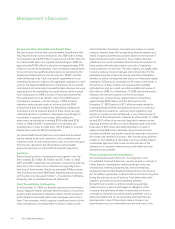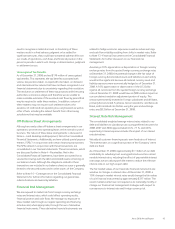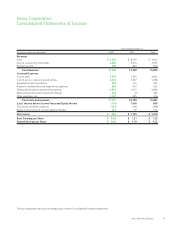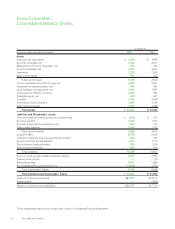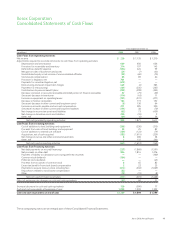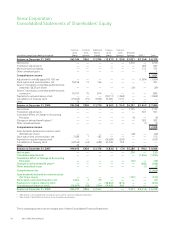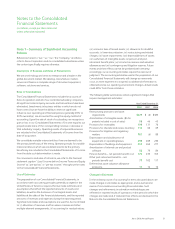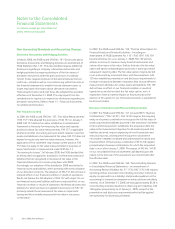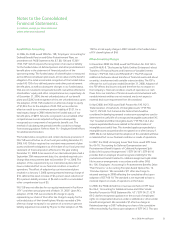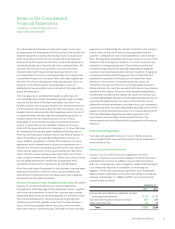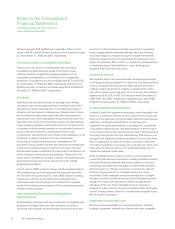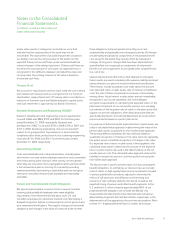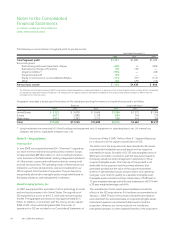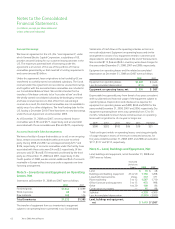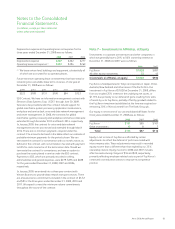Xerox 2008 Annual Report Download - page 55
Download and view the complete annual report
Please find page 55 of the 2008 Xerox annual report below. You can navigate through the pages in the report by either clicking on the pages listed below, or by using the keyword search tool below to find specific information within the annual report.
Notes to the Consolidated
Financial Statements
(in millions, except per share data and
unless otherwise indicated)
Benefit Plans Accounting
In 2006, the FASB issued SFAS No. 158, “Employers’ Accounting for
Defined Benefit Pension and Other Postretirement Plans, an
amendment of FASB Statements No. 87, 88, 106 and 132(R)”
(“FAS 158”) which requires the recognition of an asset or liability
for the funded status of defined pension and other postretirement
benefit plans in the statement of financial position of the
sponsoring entity. The funded status of a benefit plan is measured
as the difference between plan assets at fair value and the benefit
obligation. The initial incremental recognition of the funded status
under FAS 158 of our defined pension and other post retirement
benefit plans, as well as subsequent changes in our funded status
that are not included in net periodic benefit cost will be reflected in
shareholders’ equity and other comprehensive loss, respectively. As
of December 31, 2006, the net unfunded status of our benefit
plans was $2,842 and recognition of this net unfunded status upon
the adoption of FAS 158 resulted in an after-tax charge to equity
of $1,024. Prior to the adoption of FAS 158, we recorded an
after-tax credit to our minimum pension liability of $131, for a
total equity charge in 2006 related to the funded status of our
benefit plans of $893. Amounts recognized in accumulated other
comprehensive loss are adjusted as they are subsequently
recognized as a component of net periodic benefit cost. The
method of calculating net periodic benefit cost did not change
from existing guidance. Refer to Note 14 – Employee Benefit Plans
for additional information.
The funded status recognition and certain disclosure provisions of
FAS 158 were effective as of our fiscal year ending December 31,
2006. FAS 158 also requires the consistent measurement of plan
assets and benefit obligations as of the date of our fiscal year-end
statement of financial position effective for the year ending
December 31, 2008. Since several of our international plans had a
September 30th measurement date, this standard required us to
change that measurement date to December 31st in 2008. The
adoption of this requirement by our international plans did not
have a material effect on our financial condition or results of
operations. The effect of adoption by our international plans
resulted in a January 1, 2008 opening retained earnings charge of
$16, deferred tax asset increase of $4, pension asset reduction of
$9, a pension liability increase of $6 and a credit to accumulated
other comprehensive loss of $5.
FAS 158 was not effective for our equity investment in Fuji Xerox
(“FX”) until their annual year-end of March 31, 2007. Upon FX’s
adoption of FAS 158, we recorded a $5 charge to equity
representing our share of their after-tax charge to equity for the
unfunded status of their benefit plans. We also recorded a $44
after-tax charge to equity for our portion of a minimum pension
liability adjustment recorded by FX prior to their adoption of FAS
158 for a total equity charge in 2007 related to the funded status
of FX’s benefit plans of $49.
Other Accounting Changes
In December 2008, the FASB issued Staff Position No. FAS 140-4
and FIN 46(R)-8, “Disclosures by Public Entities (Enterprises) about
Transfers of Financial Assets and Interests in Variable Interest
Entities” (“FSP FAS 140-4 and FIN 46(R)-8”). This FSP required
additional disclosures about transfers of financial assets and about
an entity’s involvement with variable interest entities. The FSP is
effective for our fiscal year ended December 31, 2008. Adoption of
this FSP affects disclosures only and therefore has no impact on
the Company’s financial condition, results of operations or cash
flows. Since our transfers of financial assets and involvement with
variable interest entities are not material, we do not expect a
material disclosure requirement from this standard.
In April 2008, the FASB issued Staff Position No. FAS 142-3,
“Determination of Useful Life of Intangible Assets” (“FSP FAS
142-3”). FSP FAS 142-3 amends the factors that should be
considered in developing renewal or extension assumptions used to
determine the useful life of a recognized intangible asset under FAS
142, “Goodwill and Other Intangible Assets.” FSP FAS 142-3 also
requires expanded disclosures related to the determination of
intangible asset useful lives. This standard applies prospectively to
intangible assets acquired and/or recognized on or after January 1,
2009. We do not believe that the adoption of this standard will have
a material effect on our financial condition or results of operations.
In 2007, the FASB’s Emerging Issues Task Force issued EITF Issue
No. 06-10, “Accounting for Deferred Compensation and
Postretirement Benefit Aspects of Collateral Assignment Split-
Dollar Life Insurance Arrangements” (“EITF 06-10”). EITF 06-10
provides that an employer should recognize a liability for the
postretirement benefit related to collateral assignment split-dollar
life insurance arrangements in accordance with either SFAS
No. 106, “Employers’ Accounting for Postretirement Benefits Other
Than Pensions,” or Accounting Principles Board Opinion No. 12,
“Omnibus Opinion.” We recorded a $11 after-tax charge to
retained earnings in 2008 reflecting the cumulative effect upon
adoption of EITF 06-10. The standard is not expected to have a
material impact on results of operations in the future.
In 2006, the FASB ratified the consensus reached on EITF Issue
No. 06-2, “Accounting for Sabbatical Leave and Other Similar
Benefits Pursuant to FASB Statement No. 43” (“EITF 06-2”). EITF
06-2 clarifies recognition guidance on the accrual of employees’
rights to compensated absences under a sabbatical or other similar
benefit arrangement. We recorded a $7 after-tax charge to
Retained earnings in 2007 reflecting our share of the cumulative
effect recorded by Fuji Xerox upon adoption of EITF 06-2. This was
Xerox 2008 Annual Report 53



